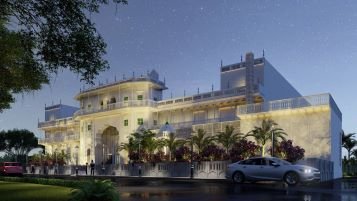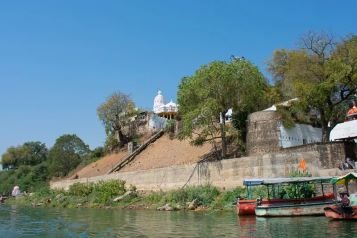Mailing List
Sign up for our mailing list to get latest updates and offers.
Madhya Pradesh, the heart of India, is a land rich in history, culture, and architectural splendor. Among its many historical treasures, the palaces of Madhya Pradesh stand as magnificent testimonials to the state's regal past. These palaces, built by various dynasties, showcase a blend of architectural styles and house stories of royalty, grandeur, and heritage. Let's take a tour through some of the most iconic palaces of Madhya Pradesh.
Jai Vilas Palace, located in the city of Gwalior, is an epitome of opulence and architectural grandeur. Built in the 19th century by Maharaja Jayaji Rao Scindia, the palace combines Tuscan, Italian, and Corinthian architectural styles. The Durbar Hall, with its massive chandeliers, gilded furniture, and ornate ceilings, is a highlight. Part of the palace is now a museum, showcasing the Scindia family's artifacts, including a silver train that served as a dining table centerpiece.

Man Mandir Palace, also in Gwalior, is a stunning example of Rajput architecture. Built by Tomar ruler Man Singh Tomar in the late 15th century, the palace is known for its elaborate carvings and colorful tile work. The palace complex includes several historic structures, including the Vikram Mahal and Karan Mahal. The palace offers a glimpse into the lifestyle of the Rajput royals and their architectural prowess.

Jahangir Mahal in Orchha is a magnificent palace built by Raja Bir Singh Deo in the early 17th century to honor the visit of Mughal Emperor Jahangir. The palace is a fine blend of Mughal and Rajput architecture, featuring ornate jali work, multi-arched openings, and decorative brackets. The palace offers panoramic views of the Betwa River and the surrounding landscape.

Raj Mahal, another architectural marvel in Orchha, was the royal residence of the Bundela kings. Built in the 16th century, the palace is adorned with beautiful murals depicting religious themes and daily life. The palace's elevated position provides stunning views of the town and the surrounding countryside.

Perched on the banks of the Narmada River, Ahilya Fort is named after the revered Queen Ahilyabai Holkar. The fort, originally built as a strategic military base, was transformed into a royal residence by Ahilyabai. Today, it operates as a heritage hotel, offering guests a unique experience of royal living. The fort complex includes ancient temples, courtyards, and the queen's palace, all set against the tranquil backdrop of the river.

Lal Bagh Palace in Indore is one of the grandest residences of the Holkar dynasty. Built in the late 19th century, the palace reflects the European architectural style, complete with Italian marble columns, grand chandeliers, and rich Persian carpets. The palace's gardens and interiors speak of the luxurious lifestyle of the Holkars, making it a must-visit for history and architecture enthusiasts.

Kanch Mahal, located in Burhanpur, is a lesser-known yet stunning palace built during the Mughal era. The palace is known for its exquisite glasswork and intricate stone carvings. Although now in ruins, Kanch Mahal offers a glimpse into the Mughal architectural brilliance and the grandeur of the past.

Sardar Manzil, also known as Shaukat Mahal, is a historic palace in Bhopal. It served as the hall of public audience for the Nawabs of Bhopal. The palace features a unique blend of Gothic and Islamic architectural styles, with pointed arches, elaborate carvings, and beautiful balconies. Today, it houses government offices but remains a significant architectural landmark in Bhopal.

Sheesh Mahal in Datia, also known as the Glass Palace, is a spectacular example of Bundela architecture. Built by Raja Bir Singh Deo in the 17th century, the palace is known for its mirror work, intricate murals, and beautiful lattice work. The palace's seven stories and strategic location offer panoramic views of the surrounding landscape.

Moti Mahal, located in Gwalior, is a historic palace known for its stunning architecture and exquisite interiors. The palace served as the administrative headquarters of the Scindia rulers. Its name, meaning "Pearl Palace," reflects the elegance and beauty of its design, with richly decorated halls and intricate carvings.

Rani Kamlapati Palace, located on the banks of the Upper Lake in Bhopal, was built in the 18th century by Queen Kamlapati, the widow of Nizam Shah Gond. The palace is a blend of Mughal and Malwa architectural styles and offers stunning views of the lake. It stands as a symbol of the queen's resilience and is a significant historical site.
Gauhar Mahal, built by Qudisiya Begum in the early 19th century, is an architectural gem located near the Upper Lake. The palace combines Mughal and Hindu styles and is known for its intricate carvings and beautiful interiors. Gauhar Mahal has been partially restored and now hosts various cultural events and exhibitions.
Shaukat Mahal, also known as Sadar Manzil, is an architectural marvel in Bhopal. Constructed in the early 19th century, it features a unique blend of Gothic and Islamic architectural styles. The palace, with its pointed arches and ornate designs, served as the hall of public audience for the Nawabs of Bhopal.
Jahangir Mahal in Orchha is a magnificent palace built by Raja Bir Singh Deo in the early 17th century to honor the visit of Mughal Emperor Jahangir. The palace is a fine blend of Mughal and Rajput architecture, featuring ornate jali work, multi-arched openings, and decorative brackets. The palace offers panoramic views of the Betwa River and the surrounding landscape.
Koshak Mahal in Chanderi is an impressive structure built by Sultan Mahmud Khilji of Malwa in the 15th century. Originally planned as a seven-story palace, only four stories were completed. The palace showcases a blend of Islamic and Hindu architectural styles and remains a significant historical monument.
Madhav Palace, located in the town of Shivpuri, was built by the Scindia dynasty. The palace, surrounded by lush gardens and forests, served as a hunting lodge and summer retreat for the Scindia rulers. It is a fine example of colonial architecture with a mix of Indian influences.
Raj Parveen Mahal, situated in Burhanpur, was built by the Mughal Emperor Shah Jahan in honor of his beloved courtesan, Raj Parveen. The palace, known for its beautiful gardens and intricate carvings, reflects the opulence of Mughal architecture and the romantic tale of Raj Parveen.
Hindola Mahal, or the "Swinging Palace," is located in the historic town of Mandu. Built during the reign of Sultan Ghiyas-ud-din Khilji in the 15th century, the palace is known for its sloping walls that give it the appearance of swaying. The unique architectural design and the large halls make it a fascinating site.
Rani Roopmati's Pavilion, perched on the edge of a cliff in Mandu, was built by Sultan Baz Bahadur for his beloved consort, Rani Roopmati. The pavilion offers breathtaking views of the Narmada River and the surrounding landscape. It is a symbol of their romantic saga and an architectural marvel.
Gujari Mahal in Gwalior was built by Raja Man Singh Tomar for his beloved queen, Mrignayani. The palace, now converted into an archaeological museum, showcases artifacts from the region's rich history. Its sturdy construction and intricate carvings are testaments to the architectural brilliance of the era.
Baz Bahadur's Palace, located in Mandu, was built by Sultan Baz Bahadur in the 16th century. The palace is known for its beautiful courtyards, spacious halls, and the unique blend of Rajasthani and Mughal architectural styles. It overlooks the Rewa Kund, a reservoir that served as a water supply for the palace.
Nilkanth Mahal, situated in Mandu, was originally built as a Shiva temple by the Mughals and later converted into a pleasure palace. The palace offers stunning views of the surrounding valleys and waterfalls. It is a tranquil site, reflecting the harmony of nature and architecture.
Moti Mahal in Mandla is a historic palace known for its architectural beauty and strategic location. The palace, built by the Gond rulers, features intricate carvings and offers panoramic views of the Narmada River. It stands as a testament to the region's rich cultural heritage.
Baghelin Palace, also located in Mandla, is another example of the architectural prowess of the Gond rulers. The palace is known for its beautiful courtyards, intricate woodwork, and strategic location near the river. It reflects the grandeur of the Baghela dynasty.
Rajwada Palace in Indore is a seven-story historic palace built by the Holkars of the Maratha Empire. The palace is an architectural marvel, blending Maratha, Mughal, and French styles. Its grand facade, intricate carvings, and expansive courtyards make it a prominent landmark in Indore.
Govindgarh Palace, located near Rewa, was the summer capital of the Rewa dynasty. The palace is known for its beautiful architecture, sprawling gardens, and the nearby Govindgarh Lake. It was once home to the famous white tigers of Rewa.

Manik Bagh Palace in Indore is an exquisite example of modern architectural design. Built in the 1930s by Maharaja Yashwant Rao Holkar II, the palace was designed by German architect Eckart Muthesius. The palace is known for its Art Deco style and luxurious interiors.
Narmada Kothi, situated in Barwaha, was built by the Holkar rulers as a summer retreat. The palace is located on the banks of the Narmada River, offering serene views and a tranquil environment. Its colonial architecture and lush surroundings make it a perfect getaway.

Shiv Vilas Palace in Shivpuri was built by the Scindia rulers as a royal residence. The palace is known for its grand architecture, beautiful gardens, and luxurious interiors. It now serves as a heritage hotel, offering a regal experience to its guests.
Ranjit Vilas Palace in Ratlam is a historic palace known for its architectural beauty and royal legacy. The palace features a blend of Indian and European architectural styles, with grand halls, beautiful gardens, and intricate designs.
Rajwada, also known as the Holkar Palace, is a seven-story structure located in the heart of Indore. Built by the Holkar dynasty, the palace showcases a blend of Maratha and Mughal architectural styles. It is a significant landmark, reflecting the grandeur of the Holkars.

Badal Mahal in Mandu is a historic palace known for its unique architectural design. The palace, built by Sultan Baz Bahadur, features beautiful courtyards, spacious halls, and intricate carvings. It offers stunning views of the surrounding landscape.
Ramnagar Palace, located near Rewa, is a historic palace known for its architectural splendor and royal legacy. The palace features beautiful courtyards, intricate carvings, and grand halls, reflecting the opulence of the Rewa dynasty.
Hardaul Palace in Orchha is a historic structure built in honor of Prince Hardaul, a revered figure in Bundelkhand's folklore. The palace is known for its simple yet elegant architecture and holds significant cultural and historical importance in the region.
Mastani Mahal, originally located in Pune, was reconstructed in the Kelkar Museum. It was built by Bajirao I for his beloved consort, Mastani. The palace showcases beautiful woodwork, intricate carvings, and reflects the romance and tragedy of Mastani's story.

Noor-Us-Sabah Palace, situated in Bhopal, was built in the 1920s for Abida Sultan, the eldest daughter of the last ruling Nawab of Bhopal. The palace, now a heritage hotel, combines Islamic and European architectural styles. It offers panoramic views of the Bhopal cityscape and the tranquil Upper Lake.

Madhya Pradesh's palaces are not just architectural wonders but also repositories of history and culture. Each palace, with its unique design and historical significance, offers a glimpse into the regal lifestyle and artistic achievements of the past. Exploring these palaces is like stepping back in time, where every room and corridor tells a story of opulence, power, and heritage. Whether you're a history buff, an architecture enthusiast, or a traveler seeking new experiences, Travelicious MP offers customised tours that include a visit to these palaces for an enriching and unforgettable journey into the heart of India's royal past.